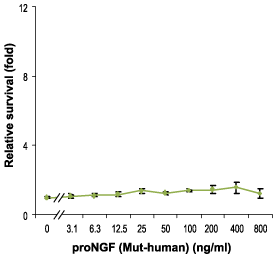Overview
- Lee, R. et al. (2001) Science 294, 1945.
- Rattenholl, A. et al. (2001) Eur. J. Biochem. 268, 3296.
 Alomone Labs Recombinant human proNGF (cleavage resistant) protein does not promote survival of PC12 cells.Cells were grown in the absence of serum and collagen, and in the presence of varying concentrations of Recombinant human proNGF (cleavage resistant) protein (#N-285). Cell survival relative to the control was measured by the XTT method, and plotted against Recombinant human proNGF (cleavage resistant) protein concentration.
Alomone Labs Recombinant human proNGF (cleavage resistant) protein does not promote survival of PC12 cells.Cells were grown in the absence of serum and collagen, and in the presence of varying concentrations of Recombinant human proNGF (cleavage resistant) protein (#N-285). Cell survival relative to the control was measured by the XTT method, and plotted against Recombinant human proNGF (cleavage resistant) protein concentration. Alomone Labs Recombinant human proNGF (cleavage resistant) protein promotes neurite outgrowth in PC12 cells.Cells were grown on collagen-coated 24 well plates in DMEM medium supplemented with 6% fetal calf serum and 6% horse serum for 24 h. Recombinant human proNGF (cleavage resistant) protein (#N-285) was added at the indicated concentration. The culture media was changed every 2-3 days. The development of neurites over a period of 5 days was visualized by Methylene Blue staining.
Alomone Labs Recombinant human proNGF (cleavage resistant) protein promotes neurite outgrowth in PC12 cells.Cells were grown on collagen-coated 24 well plates in DMEM medium supplemented with 6% fetal calf serum and 6% horse serum for 24 h. Recombinant human proNGF (cleavage resistant) protein (#N-285) was added at the indicated concentration. The culture media was changed every 2-3 days. The development of neurites over a period of 5 days was visualized by Methylene Blue staining.
- Roux, P.P. and Barker, P.A. (2002) Prog. Neurobiol. 67, 203.
- Lessmann, V. et al. (2003) Prog. Neurobiol. 69, 341.
- Rattenholl, A. et al. (2001) Eur. J. Biochem. 268, 3296.
- Hasan, W. et al. (2003) J. Neurobiol. 57, 38.
- Lee, R. et al. (2001) Science 294, 1945.
- Fahnestock, M. et al. (2004) J. Neurochem. 89, 581.
- Althaus, H.H. and Kloppner, S. (2006) J. Neurochem. 98, 506.
- Pedraza C.E. et al. (2005) Am J Pathol. 166, 533.
- Beattie, M.S. et al. (2002) Neuron 36, 375.
The proneurotrophins (proNT) are, as their name suggests, the proform of the neurotrophins. The neurotrophins (NT) are a family of soluble, basic growth factors which regulate neuronal development, maintenance, survival and death in the CNS and the PNS.1 They exert their biological effects by binding to two types of receptors: the Trk receptors, and the p75NTR receptor.
Like many other proteins, mature NT arise from the proteolytic cleavage of the precursor form by various proteases: plasmin, furin, MP7, PC1/3, PC2, PC5/6, PC7 and PACE4, which cut behind a pair or even a single basic residue.2 This has been known for many years, and it was thought that the roles of the prodomain were to aid in the folding of the mature protein and to sort the mature neurotrophin into the various secretion pathways.3 However, recently an assortment of papers have been published which suggest new roles for the proNT. It has been found that proNerve Growth Factor (proNGF), and not mature NGF, is the predominant isoform found in the human brain as well as in a variety of cell types, including mast cells, sciatic nerve cells, thyroid gland, skeletal muscle, prostate gland, hippocampus and hair follicle.4 Thus, the case of the mouse salivary gland, which is the most abundant source of mature NGF, seems to be the exception and not the rule.
proNGF is the ligand preferred by p75NTR.5 Therefore, cleavage resistant proNGF (mutated at the cleavage site to insure that it retains the prodomain) induced apoptosis ten times more effectively than mature NGF in a vascular smooth muscle cell line expressing p75NTR but not Trk receptors.5 However, proNGF can also mediate survival. Rattenholl et al. have shown that proNGF was as effective as NGF in inducing survival of DRG neurons.3 Fahnestock et al. have shown that a mutated proNGF exhibits neurite outgrowth on both PC12 cells and mouse sympathetic cervical ganglions.6
A neccesary but not sufficient partner for proNGF is sortilin, a 95 kDa member of the Vps10p domain receptor family which is expressed in a variety of tissues, notably brain, spinal tissue and muscle. However, not all cells expressing p75NTR and sortilin react to proNGF by becoming apoptotic. For example, in mature pig oligodendrocytes, which express p75NTR and sortilin, proNGF induces survival.7
A close analysis of the literature shows that there are at least four types of proNGF which have been used in biological assays. One, produced in mammalian cell culture, contains two mutations at the furin cleavage site, two mutations at the C-terminus, and the addition of a C-terminal His tag.5 A second proNGF, produced in baculovirus, has only one mutation, at the cleavage site.6 A third proNGF has been purified from the brains of Alzheimer’s patients, and is highly glycosylated.8 A fourth, with no mutations, has been expressed and purified from E.coli.3 The large variation between results obtained may be due to the different types of preparations assayed. Another crucial issue is the cell type and origin. Even in cells of the same type, for example, in oligodendrocytes: opposing effects of proNGF were seen in rat oligodendrocytes where it caused apoptosis,9 however, in pig oligodendrocytes it induced survival.7 It should be noted that rat and pig oligodendrocytes do not express the same panel of receptors: rat oligodendrocytes do not express TrkA whereas pig (and human) oligodendrocytes do.
Recombinant human proNGF (cleavage resistant) protein (#N-285) is a highly pure, recombinant, and biologically active protein.
Applications
Citations
- Guo, J. et al. (2013) Stem Cell Res. 11, 874.
- Marchetti, L. et al. (2013) J. Cell Sci. 126, 4445.
- Demont, Y. et al. (2012) J. Biol. Chem. 287, 1923.

